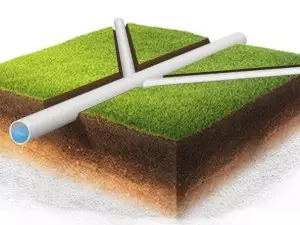
The flooding of the site with soil and thawed waters may be a real disaster for its owner. The sediments are also able to contribute to the violation of the soil structure. It is especially bad for the owners of the Earth, consisting mainly of clay or loam, since the clay is strongly detaining the water, with difficulty passing it through itself. In these cases, the sole rescue may be correctly built drainage. For such soil, he has its own characteristics. Therefore, consider how to make a drainage of the site with your own hands on clay soils.
Features of clay plots
Plants suffer from the re-fulfillment of moisture in the first place. Their roots are not obtained by the amount of oxygen necessary for the development. The result turns out to be a deplorable - plants first come, and then they disappear at all. Moreover, this also applies to cultural plants, and to lawn herbs. Even in cases where clay from above is covered with a layer of fertile soil, water departing will be difficult.
It is also important to comfort work on the site, because in the absence of drain, even a small rain is capable of turning clay soil in a swamp. It is impossible to work on such land for several days.
When the water does not leave for a long time, the risk of flooding the foundation and its freezing during cold weather occurs. Even very good waterproofing is not capable of protecting the foundation from destruction, since it itself can be destroyed by frozen moisture.
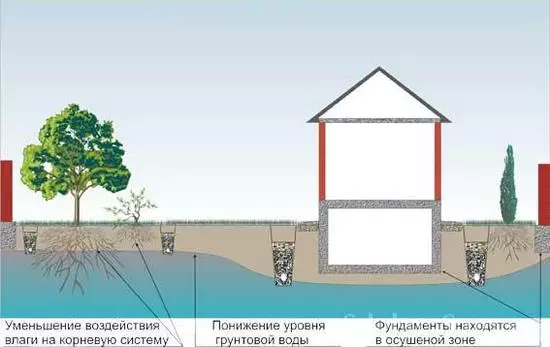
Advantages of the presence of a drainage system on the plot
We conclude: the drainage of the plot from groundwater is simply necessary. And if it is not yet done, then you should not postpone its construction.
Preparation for the construction of a drainage system
Before choosing a type of drainage system, an analysis of your site should be analyzed.
Attention is drawn to the following points:
- Soil structure. In our case, clay is considered, which is not able to quickly pass water;
- Source of high moisture. It can be frequent precipitation or groundwater closer to the surface;
- The type of drainage is selected or several types are combined;
- The plan for the location of drainage trenches, revision and catchment wells is drawn up. The plan indicates the depth of finding the drain, the size of all elements of the system, their slope relative to the surface of the soil. The plan will allow you to quickly find the location of all elements of the system.
Article on the topic: "Flying" bed do it yourself
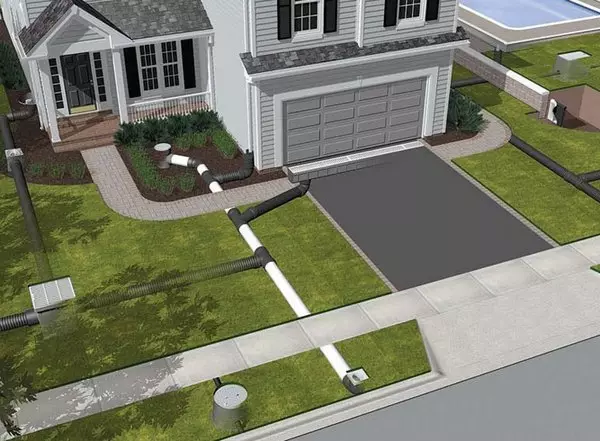
The layout of the elements of the drainage system on the site
After such training, the construction of the area drainage is proceeded with their own hands on clay soils. Consider what kind of drainage it happens, and which one is better suited to the clay area.
Types of drainage systems
Drainage on the clay area can be superficial, deep or reservoir. Sometimes it is advisable to combine several of these species to achieve the greatest drainage efficiency.Surface drainage
If the site has at least a small natural bias, it creates additional benefits for surface drainage. Water flows by itself along the channels in the reserved place on the site. Such channels are located on the surface of the soil, slightly deepening them into the ground. Surface drainage of the area on clay soils can be laid on almost any level places: along the tracks, around the structure, around the perimeter of lawns, near platforms for recreation and in other places.
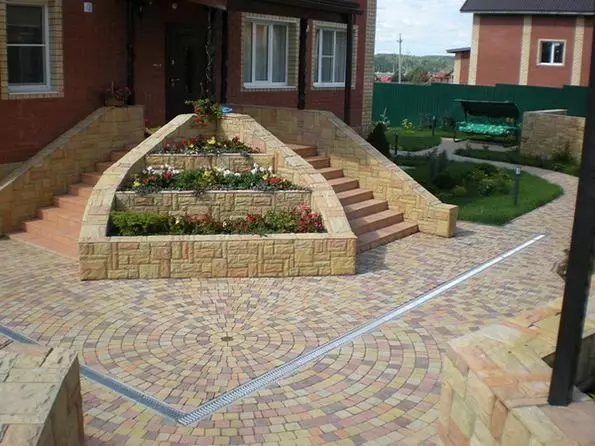
Example of a device of surface drainage from drainage trays
Water flowing through concrete or plastic grooves is assembled in drainage wells, from where it is used for purpose or reset to the disposal location.
Depth drainage
When it is necessary to remove significant amounts of water from the soil, decay deep drainage in clay soils. This is an underground channel system and pipelines located in them, for which water flows and accumulates in wells. The system is one or more trunk (basic) channels having a depth of about 1.2 m and the width of about 50 cm with drainage pipes laid in them. The direction of the main channels is to the catchment collector. These channels are resetting water from auxiliary channels that collect water from the entire area. They have a smaller depth and width. The number of additional channels should be so as covered by places with the greatest water stagnation.
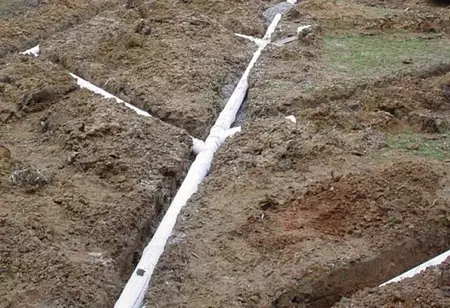
Device of deep drainage
Tip: The more clay is contained in the soil, the greater the amount of drainage lines will need to be paved.
The distance between the drains on such a soil type is a maximum of 11 meters.

Recommended distance between drainage pipes depending on the type of soil and trench depth
Plasty drainage
This is a kind of variety of the deep system, since all the drainage elements are located at a considerable depth. The plastic drainage is used in cases where it is necessary to remove the water constantly entering the foundation. Plastic drainage shutdown Under the foundation itself, having it deeper the lower point of the foundation . The system consists of a layer of rubble, through which water goes into the drainage pipes located around the perimeter. The dimensions of the reservoir system always exceed the structure of the structure.
Article on the topic: Gymelocoes under painting: pasting and painting with your own hands
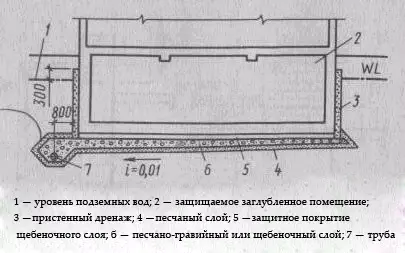
Plastic drainage device diagram
Tools and materials
We list the tools that may be needed in order to carry out drainage in clay:- Shovels for digging trenches.
- Construction level to create a slope in trenches.
- Wheelbarrow for the enclosure of materials and the export of ducklings.
- Cutting and drilling tool for plastic pipes.
- Marking cord.
For work, such materials will be required:
- The geotextile required to filter the water flowing into the drainage system.
- Crushed stone and sand to create pillows and sprinkles.
- Channels made of concrete or plastic for surface drainage, rain-seekers, sandcloths, as well as cement.
- Perforated plastic tubes with diameters 100-110 mm for the construction of a deep drainage.
- Connecting elements for docking pipes.
- Ready drainage wells or elements for their assembly.
Drainage device
Consider how to make a drainage of a plot on the clay soil of different types.
Surface drainage
A simpler device has an open flowing type of drainage:
- According to the existing plan, the shallow trenches are swap, which will thoroughly tram. The slope of trenches towards the waterborns is observed. If you are lucky, and the plot has a natural bias, the trench depth may be the same. Trench depth comes to 80 cm, and their width is 40 cm.
- A sand pillow is formed in the trenches, on top of which the layer of rubble is falling asleep. Since the drainage device on the clay soil is open, the crushed stone will fall asleep to the soil level or the place for laying on top of the strain layer is left. In this form, the system is operated.
Tip: To give open channels greater aesthetic, it is recommended to cover them on top of decorative stones, pebbles, decorate in other ways. From them you can form a dry stream by putting perennial flowers along the edges of the channels.
Drainage of the tray type is formed as:
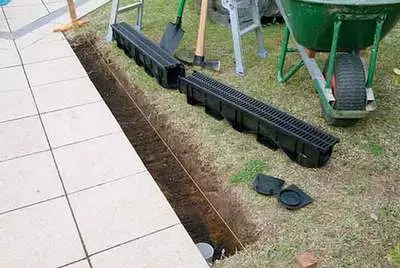
Installation of plastic drainage trays
- Verit trenches, as in the previous version, but not so deep.
- A concrete solution is poured on the rubble layer, which is immediately installed plastic or concrete chute. Concrete fixes trenches, not allowing earth walls to collapse. Similarly, sandcloths are installed (usually at the end of the tray line) and rain-seekers (under drainage pipes).
- The gutter is closed with protective lattices.

Scheme stacking drainage gutters with sand-trap
Depth drainage
This is a better drainage system, the manufacture of which will require a lot of time and strength.
- A collector well is installed on the velocked place.
- Main and auxiliary trenches of about 50 cm wide are swapped. The average drainage depth on the clays is about 120 cm in the main channels and about 100 cm in the channels of additional. The main lines should reach the catchment well. The slope of the auxiliary trenches is provided by 5 cm per meter of their length.
- At the bottom of the dug trenches, the pillow of sand is covered and geotextiles are laid out, the edges of which are wrapped on the walls of trenche.
- From above geotextile, crushed a thickness of at least 20 cm is stacked.
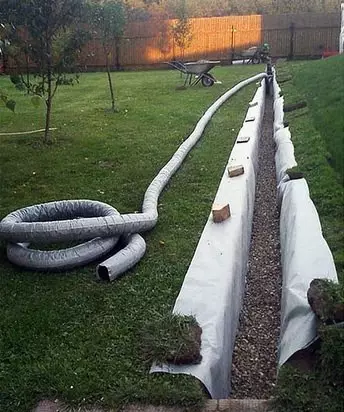
Preparation of trenches for stacking drain
- Painted perforated pipes with a mandatory verification of the slope.
- Pipes between themselves are allowed using fetal or coupling connections.
- In places of turns of pipes, as well as every 25 m in direct areas, auditing wells are mounted. It can be chunks of a pipe of large diameter or specially made products. Their height should be so that they rise above the level of soil. Through these wells will be controlled by purity of pipelines, as well as their periodic cleaning.
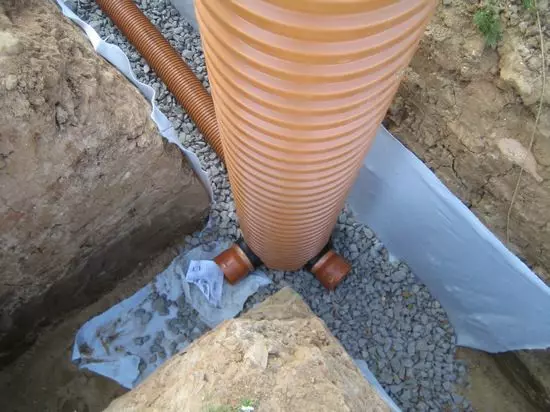
Drainage observation well
- Top of pipes again falls asleep crushed stone. It must completely cover the pipes.
- Geotextile wrap so that rubble, along with the pipes, was in his cocoon. The filter for drainage is provided.
- The place remaining in the trenches falls asleep by sand.
- The last layer is the soil, which is leveling trenches to the soil level.
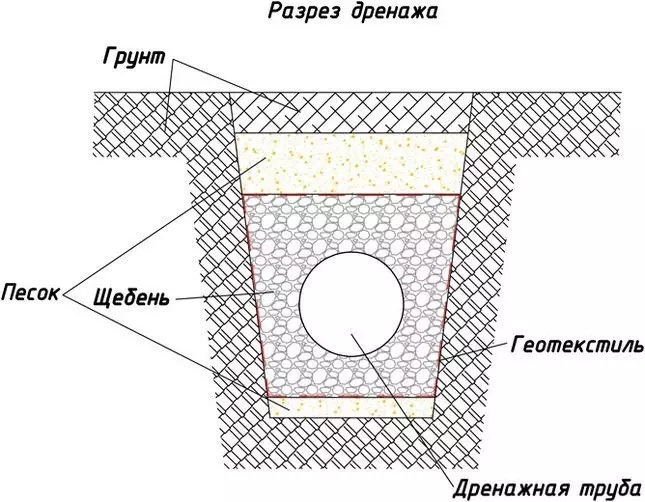
Drainage pipe laying scheme in trench
Plasty drainage
This variety of drainage is created even before the construction of the foundation. The soil is deepened below its location at least 20 cm. The soil layer is also laid wider location of the foundation. On the bottom of the pit, rubble layer 20 cm laying up, and drainage pipes are located around the perimeter. All the moisture penetrating under the foundation is collected in the pipes, from where it is excreted from separately paved pipelines into the catchment wells.
Tip: Depth of finding a reservoir drainage should exceed the depth of the clay soil. In this case, the drainage will be as efficient as possible.
This kind of drainage is quite laborious, therefore it is used less often, although it is useful for clay soils.
Caring for the drainage system consists only in its cleaning and pumping of water from the collector well. If everything is done correctly, then no clay on the plot can darken your mood and destroy the plants grown.
Article on the topic: Brick laying with your own hands
